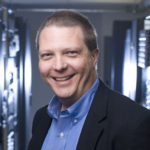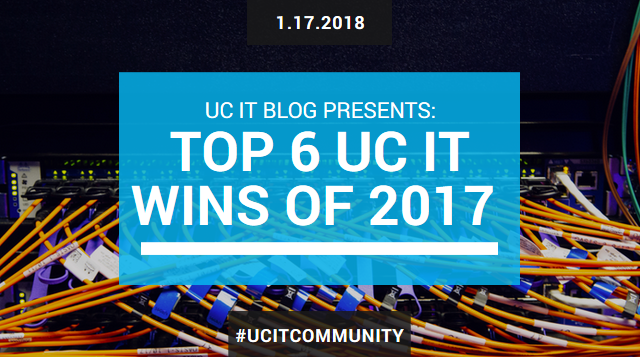By Tom Andriola and Matt Hall. Started last year, and now a tradition, the campus CIOs are presenting our list of record-setting accomplishments in UC IT for 2017. We just couldn’t narrow the list to five, so here are six. They demonstrate how UC IT works together across locations, making the whole greater than the sum of its parts.
Enjoy the list and feel free to add your own ideas in the comments.
6. IT supports smart manufacturing
UCLA was a driving force behind the startup of the Smart Manufacturing Innovation Institute (SMII) and development of a public-private IT infrastructure on a national scale. Led by Jim Davis, UCLA vice provost for information technology, the SMII is creating a shared data infrastructure for the purpose of improving the nation’s competitiveness in manufacturing. Leveraging the IT and research expertise of universities, commercial IT providers, and major companies, the shared platform offers advanced IT capabilities along with modeling, simulation, controls, optimization, artificial intelligence, machine learning, data analytics, and data sciences capabilities. Several UC campuses are participating in the shared infrastructure, and the San Diego Supercomputing Center at UCSD is supporting the coordination of advanced computing resources.
5. Threat detection and identification software installed across UC
UC deployment of FireEye threat detection and identification (TDI) software accelerated in 2017 and, by the end of December, eleven of fifteen UC locations had implemented it fully. The rest were in the process of implementation or planning next steps. This rapid rate of adoption and deployment was in part due to the “early adopter” locations, including UCR, UCLA, and UCSB, sharing their success stories with the others. FireEye is now our core technology for TDI and locations are pleased with its ability to produce high-fidelity, actionable alerts. We also are now able to better track trends across UC and help inform executive decisions about cyber risk.
4. UC prepares for the future of healthcare
In November, UC San Diego Health incorporated UC Irvine Health into its instance of the Epic electronic medical records (EMR) system. The event culminated a two-year effort to bring the San Diego, Irvine, and Riverside health enterprises onto a common software platform for managing patients. As a result, UCI cut its cost of EMR implementation by 30 percent; UCR upgraded to a platform that can support the growth of its health clinics; and, with a single system, UC Health will be better positioned to grow and expand markets. Plus, it’s a first for US academic medical centers to share a platform! This effort is a perfect example of how we can combine our assets and services at UC to provide better and more efficient services while not losing our local identities – and an example of just how strategic IT can be.
3. Web accessibility resources for everyone
UC is committed to making its websites accessible to everyone, and in particular people with disabilities. We adopted the IT Accessibility Policy, we maintain an accessibility resources website, and now we have a systemwide contract with Siteimprove for accessibility monitoring software, as well as online training courses in accessibility. With funding provided through Risk Services at UCOP, the tool and training will be made available in early 2018. Look for a more detailed announcement soon. It should be noted that IT and Procurement worked hard together to get the best products for the best pricing. UC is proud to stand up for accessibility and proud that we will be making accessibility resources available to every single UC employee.
2. Machine learning gets its own cloud
Machine learning (ML) – when computers learn without being explicitly programmed to do something –is one of the fastest growing fields in computer science and engineering. It supports advanced research in many other fields, including mobile computing platforms, smartphones, robots, drones, and self-driving vehicles. But ML research has been limited by the availability of graphics processing units (GPUs) for off-line computing with very large datasets. Led by Larry Smarr, director of Calit2 at UCSD and UCI, and Tom DeFanti, research scientist at UCSD, an NSF funded project called CHASE-CI – or Cognitive Hardware and Software Ecosystem Community Infrastructure – is bringing together a multi-campus community of ML researchers to build a cloud of hundreds of affordable GPUs, networked together at ultra-high speeds with a variety of neural network machines to facilitate development of next-generation cognitive computing.
1. UC IT community just gets bigger and better
Just a lot happened this year in community building. The UC IT Blog reached over 1600 subscribers, with upwards of 75% of the articles from campus authors. The UC Tech Slack team has over 3000 members, 250 public channels, and is the first-ever IM service for all UC. We launched the UC IT Portal, a one-stop shop for systemwide IT. And the biggest ever annual UC Computing Services Conference (UCCSC) was held in August at UCSD with over 550 attendees. UCCSC is no longer just a conference. It’s a major community-building event, with a theme, awards, spin-out activities, and each year, a focus on getting a new IT community involved – health IT, research IT, library IT… Congratulations to all of you for all you do. We can’t wait to see what’s next.
 Tom Andriola is chief information officer of University of California .
Tom Andriola is chief information officer of University of California .
 Matt Hall is UC Santa Barbara chief information officer and current chair of the UC IT Leadership Council.
Matt Hall is UC Santa Barbara chief information officer and current chair of the UC IT Leadership Council.

